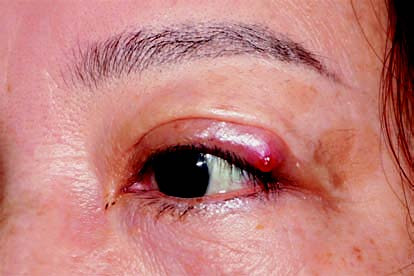Hordeolum, commonly known as a stye, is an acute suppurative inflammation of the meibomian glands or sebaceous glands of the eyelid. Infection of the eyelash follicle or its associated sebaceous glands (Zeis gland) or apocrine sweat glands (Moll gland) is referred to as external hordeolum. Infection of the meibomian glands is referred to as internal hordeolum. The condition is most often caused by a Staphylococcus infection, particularly Staphylococcus aureus.
Clinical Manifestations
The affected area displays typical signs of acute inflammation, including redness, swelling, heat, and pain.
External Hordeolum
The inflammation primarily involves the eyelid margin near the base of the eyelashes. In the early stages, the redness and swelling may be diffuse, and palpation often reveals a hard nodule with significant tenderness.

Figure 1 External hordeolum with abscess formation and rupture
Internal Hordeolum
The inflammation is localized within the meibomian glands and usually presents with more pronounced swelling and pain. A hard, tender nodule may be palpable, and localized congestion and swelling can often be observed on the palpebral conjunctiva.
Two to three days after onset, a yellow pustule may form. In external hordeolum, the pustule often progresses outward to the skin surface, where it can rupture spontaneously, softening the nodule. In internal hordeolum, the pustule typically forms on the conjunctival side of the eyelid, rupturing into the conjunctival sac or, less frequently, breaking through the skin. After rupture, the inflammation subsides significantly, usually improving within 1–2 days and resolving completely in about one week. Some cases resolve spontaneously without the need for incision and drainage.
In children, the elderly, or individuals with chronic debilitating conditions such as diabetes, weakened immunity and poor resistance may allow aggressive virulent pathogens to cause more severe complications. Hordeolum can spread to the subcutaneous tissue of the eyelid, resulting in diffuse redness and swelling of the entire eyelid. In such cases, adjacent areas, such as the same side of the face, may be affected, leading to eyelid cellulitis. Eyelid swelling may become so severe that the affected eye cannot open. The eyelid may feel firm to the touch and is often associated with significant tenderness. Severe edema of the bulbar conjunctiva can occur, which may protrude from the palpebral fissure. Systemic symptoms such as fever, chills, and headache may accompany severe cases. If left untreated, this condition may lead to life-threatening complications, including sepsis or cavernous sinus thrombosis.
Diagnosis
The diagnosis is relatively straightforward based on the clinical symptoms and changes in the eyelid. Hordeolum should be distinguished from a meibomian gland cyst caused by obstruction of the gland's opening (chalazion). Chalazion is a chronic, sterile, granulomatous inflammation with no signs of infection, commonly known as a "lipogranuloma."
Treatment
Early Stage Management
Local warm compresses (10–15 minutes, 3–4 times daily) may help alleviate symptoms and promote resolution of the inflammation. Topical antibiotic eye drops are generally applied 4–6 times daily. For recurrent cases or those with systemic symptoms, oral antibiotics may be indicated.
Management of Abscess Formation
When an abscess forms, surgical incision and drainage are required. For external hordeolum, the incision is placed on the skin side, parallel to the eyelid margin and aligned with the natural skin folds to minimize scarring. If the abscess is large, placement of a drainage strip may be necessary. For internal hordeolum, incisions are typically made on the conjunctival side, perpendicular to the eyelid margin, to reduce damage to the meibomian ducts.
Precaution Against Premature Incision
Incisions should be avoided if an abscess has not yet formed. If the infection spreads, eyelid cellulitis or serious complications such as cavernous sinus thrombosis or sepsis may occur, potentially leading to life-threatening outcomes. In such cases, systemic administration of broad-spectrum antibiotics targeting Staphylococcus aureus is essential. Bacterial culture and sensitivity testing of the pus or blood can help guide the selection of the most suitable antibiotic.